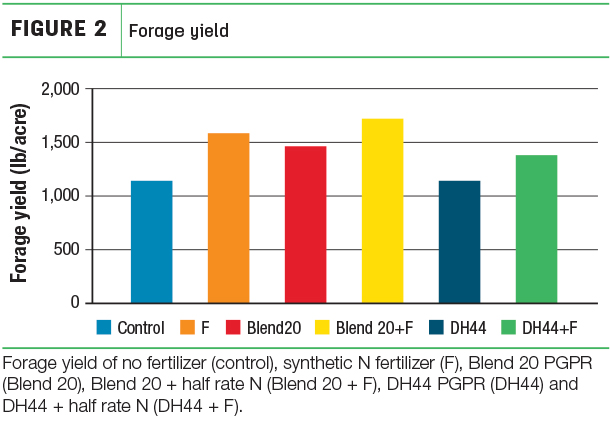Soil is made up of four broad categories: minerals (about 45%), air (about 25%), water (about 25%), and organic matter (about 5%). While we like to think of soil as a nonliving entity, the organic matter portion is a vital living system. It is made up of the residue of dead plants and animals, as well as living organisms that consume these residues.
Most biological activity in the soil occurs in the top 4 inches; this is where exchange of air and organic matter occurs. Soil organisms can be divided into microorganisms (e.g., bacteria, fungi, protozoa, nematodes and mites) and macroorganisms (e.g., ants, beetles and worms). The diversity of soil organisms is so extensive, it is estimated that only 5% of these organisms have been discovered. All of these organisms work together to recycle nutrients, maintain soil structure, suppress plant disease and detoxify the soil.
Due to the importance of this diversity, interest in microbial soil amendments is on the rise. Each amendment contains a unique blend of different microbial species and strains (e.g., mycorrhizae fungi and rhizobacteria). One group in particular that has been shown to positively affect row crops and forage pastures is plant growth-promoting rhizobacteria (PGPR). Plant growth-promoting rhizobacteria are nonpathogenic, soil-inhabiting beneficial bacteria that colonize the seeds and roots of plants. These bacteria are commonly found in soils but are concentrated in the lab to produce a biofertilizer. These bacteria benefit the host plants through increasing drought tolerance, insect resistance, nutrient uptake and increasing top and root yield.
Additionally, PGPR are antagonists toward pathogens through induced systemic resistance (ISR) by competing for nutrients, producing antibiotics and secreting lytic enzymes important in the rhizosphere of the plant. Most research with PGPR has been conducted in agronomic crops, but interest is starting to emerge in the forage arena as well.
Biofertilizers are often confused with organic fertilizers, but organic fertilizers (e.g., poultry litter and dairy effluent) only contain organic compounds which directly or indirectly increase soil fertility. Biofertilizers, on the other hand, are substances containing living microorganisms (typically bacteria or fungi) that colonize the surface of the plant root (the rhizosphere) or the interior of the plant and increase the supply of nutrients to the host plant. In a natural setting, the concentrations of these bacteria are so low that the nitrogen (N) added to the system and benefits to the plant are negligible. However, when concentrated in biofertilizers, the benefits to host plants can be easily observed.
For biofertilizers to be effective, there must already be an established symbiotic relationship between the plant host species and the bacterial species. Research at Auburn University has developed a method to select and concentrate the most beneficial of these bacteria for soil types in the Southeast.
To consider PGPR for forage crops, the nutritive quality of the forage, as well as the forage yield must be considered. Due to the increased plant-growth rate, there has been some concern of negative impacts on forage quality. A recently completed project at Auburn University has shown there was no negative impact of PGPR on forage quality of Coastal bermudagrass hay, and more importantly, in vitro digestibility actually increased when using PGPR. Also, forage N-use efficiency was 39% greater with PGPR than N-fertilized plants (Figure 1).

Additional research on stockpiled Coastal bermudagrass has shown that fertilizing with DH44 (an experimental Auburn PGPR bacterial blend) had greater forage yields than commercial N-fertilizer alone (Figure 2).

Not only does PGPR provide increased nutrient supply resulting in greater forage yield, it has also been shown to increase resistance to crop disease and decrease insect pressure. This occurs because PGPR improves water and nutrient uptake, allowing the plant to regrow tissues in the presence of insects. These effects are dependent on insect species, but research in turf-type bermudagrass has shown the use of PGPR can deter egg laying by fall armyworm moths. There is also interest in determining the effects of PGPR fertilization on bermudagrass stem maggot damage in bermudagrass hayfields.
Research at Auburn University has shown that PGPR stay in the host plant for up to 12 weeks during the growing season. After this period, an additional application of PGPR would be required. More research is needed, but PGPR shows promise as a supplemental biofertilizer for forage grasses.
Many soil microbial amendments exist on the market. When choosing the right product, make sure the company has research to support any product claims; some products do not, and their usefulness would therefore be questionable. Furthermore, make sure this research has been completed in the plant species you are interested in fertilizing. As mentioned before, the bacteria-plant relationship is very specific, and all microbes will not work in all forage systems. Applying a reduced N fertility rate (e.g., 50% to 75%) will ensure some immediate N is available to your forages and give some assurance when using a novel product in your system.











